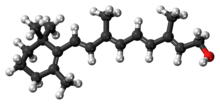Vitamin A
Vitamin A is an essential vitamin for human health. It is a fat-soluble vitamin that is found in food sources such as eggs, dairy products, liver, and orange vegetables. Vitamin A is important for healthy growth and development, as well as proper functioning of the immune system, eyesight, and reproduction. Vitamin A is also known as retinol and is necessary for regular vision, skin health, and proper cell growth. Deficiencies in vitamin A can lead to night blindness, dry skin, and even death.
Vitamin A, also known as Retina-A, Trentinoin (aka retinoic acid), or retinols, is a powerful ingredient commonly used in cosmetics for treating acne, anti-aging, and other skin issues. Vitamin A is a retinoid, meaning it is a derivative of the vitamin A molecule, and when applied to the skin, it can help reduce wrinkles, even out skin tone and texture, and may even have some anti-acne benefits such as unclogging pores, reducing oil production, and preventing bacteria growth. It can also help protect skin from UV damage by reducing inflammation and encouraging new skin cell growth. In addition to improving the texture and appearance of the skin, Vitamin A can also help reduce the appearance of scars and hyperpigmentation, improve hydration, and keep skin looking youthful.
Vitamin A is a fat-soluble vitamin and an essential nutrient for humans. It is a group of organic compounds that includes retinol, retinal (also known as retinaldehyde), retinoic acid, and several provitamin A carotenoids (most notably beta-carotene [β-carotene]). Vitamin A has multiple functions: it is essential for embryo development and growth, for maintenance of the immune system, and for vision, where it combines with the protein opsin to form rhodopsin – the light-absorbing molecule necessary for both low-light (scotopic vision) and color vision.
 | |
 Retinol | |
| Clinical data | |
|---|---|
| AHFS/Drugs.com | Monograph |
| License data | |
| Routes of administration | by mouth, IM |
| Drug class | vitamin |
| ATC code | |
| Legal status | |
| Legal status |
|
| Identifiers | |
| |
| CAS Number |
|
| PubChem CID | |
| IUPHAR/BPS | |
| ChemSpider | |
| UNII |
|
| ChEBI | |
| ChEMBL | |
| ECHA InfoCard | 100.031.195 |
| Chemical and physical data | |
| Formula | C20H30O |
| Molar mass | 286.459 g·mol−1 |
| 3D model (JSmol) | |
| Melting point | 62–64 °C (144–147 °F) |
| Boiling point | 137–138 °C (279–280 °F) (10−6 mm Hg) |
| |
| |
Vitamin A occurs as two principal forms in foods: A) retinol, found in animal-sourced foods, either as retinol or bound to a fatty acid to become a retinyl ester, and B) the carotenoids alpha-carotene, β-carotene, gamma-carotene, and the xanthophyll beta-cryptoxanthin (all of which contain β-ionone rings) that function as provitamin A in herbivore and omnivore animals which possess the enzymes that cleave and convert provitamin carotenoids to retinal and then to retinol. Some carnivore species lack this enzyme. The other carotenoids have no vitamin activity.
Dietary retinol is absorbed from the digestive tract via passive diffusion. Unlike retinol, β-carotene is taken up by enterocytes by the membrane transporter protein scavenger receptor B1 (SCARB1), which is upregulated in times of vitamin A deficiency. Storage of retinol is in lipid droplets in the liver. A high capacity for long-term storage of retinol means that well-nourished humans can go months on a vitamin A- and β-carotene-deficient diet, while maintaining blood levels in the normal range. Only when the liver stores are nearly depleted will signs and symptoms of deficiency show. Retinol is reversibly converted to retinal, then irreversibly to retinoic acid, which activates hundreds of genes.
Vitamin A deficiency is common in developing countries, especially in Sub-Saharan Africa and Southeast Asia. Deficiency can occur at any age but is most common in pre-school-age children and pregnant women, the latter due to a need to transfer retinol to the fetus. Vitamin A deficiency is estimated to affect approximately one-third of children under the age of five around the world, resulting in hundreds of thousands of cases of blindness and deaths from childhood diseases because of immune system failure. Reversible night blindness is an early indicator of low vitamin A status. Plasma retinol is used as a biomarker to confirm vitamin A deficiency. Breast milk retinol can indicate a deficiency in nursing mothers. Neither of these measures indicates the status of liver reserves.
The European Union and various countries have set recommendations for dietary intake, and upper limits for safe intake. Vitamin A toxicity also referred to as hypervitaminosis A, occurs when there is too much vitamin A accumulating in the body. Symptoms may include nervous system effects, liver abnormalities, fatigue, muscle weakness, bone, and skin changes, and others. The adverse effects of both acute and chronic toxicity are reversed after consumption of high dose supplements is stopped.









